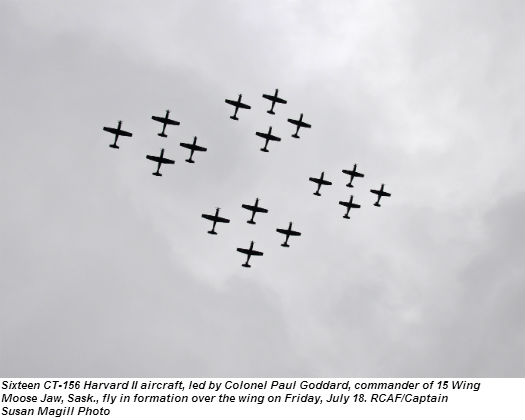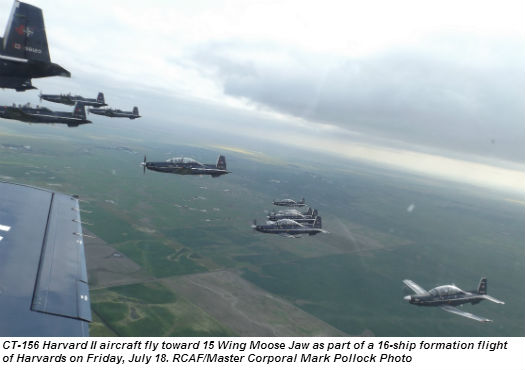RCAF Press Release | July 28, 2014
Estimated reading time 3 minutes, 30 seconds.
Despite gusty winds and grey skies, the air over 15 Wing Moose Jaw, Sask., buzzed and roared with the sounds of propellers and jet engines on the morning of Friday, July 18, as 19 aircraft lifted off to participate in a rarely seen aerobatic feat.
Sixteen CT-156 Harvard IIs and three CT-155 Hawks took part in the formation flight.
Moose Jaw is home to the NATO Flying Training in Canada (NFTC) program, which provides initial fighter pilot training for the Royal Canadian Air Force as well as NATO and allied nations. Canadian students who are chosen for multi-engine or helicopter pilot training go to Portage La Prairie, Man. Those chosen for jets stay in Moose Jaw for more training and eventually go to 419 Tactical Fighter Training Squadron (which is located at 4 Wing Cold Lake, Alta., but which belongs to 15 Wing and is part of the NFTC program).
The flight showcased the NFTC’s training aircraft, familiarized military and civilian wing personnel with flying by taking them onboard as passengers, and allowed the outgoing commander of 15 Wing, Colonel Paul Goddard, to lead his airmen and women in a formation flight.
Colonel Goddard, one of the most qualified instructors in the Royal Canadian Air Force for this type of formation flight, is passionate about flying and hands-on instruction. He regularly accompanies students on sorties and gets to know them on a personal level to provide accurate and constructive feedback, contributing to the high calibre of pilots who graduate from the program.
During the flight, pilots sharpened their formation flying skills, which is a major component of a pilot and instructor’s training. There is an immense amount of training value in a flight of this size; it requires high levels of planning, coordination and precision to fly such a large number of aircraft together.
Master Corporal Mark Pollock, who works in the wing transport section, was a passenger during the flight.
“It was very bumpy below the clouds,” he said. “I’ve flown in other [Canadian Armed Forces] aircraft before, but the excitement you get from flying in a Harvard for the first time doesn’t even compare. I spent most of the flight in awe of how close the pilots kept the aircraft together.”
Before being cleared for take-off, all passengers had to undergo a medical examination, learn how to eject from an aircraft, and become familiar with specialized flying equipment.
The 16-ship formation is larger than any other currently flying in the RCAF, including those used by the Snowbirds aerobatic team. This was only the third time in the NFTC’s history that a formation flight of this size has taken place.



